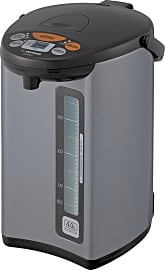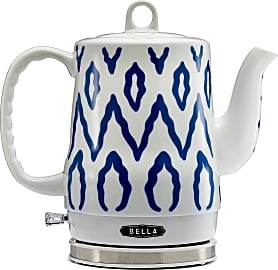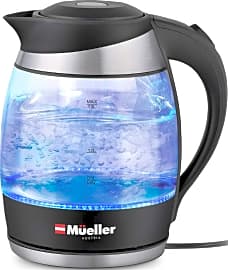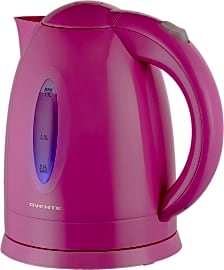The 10 Best Electric Kettles

This wiki has been updated 41 times since it was first published in April of 2015. Faster than either a microwave or a stovetop, an electric kettle is a handy convenience for tea drinkers and cooks alike. They bring water to a boil quickly and some even allow you to adjust the temperature, so you can get green and white teas just right. In addition to making hot drinks of all kinds, they can be used for instant oatmeal and any number of pasta dishes. When users buy our independently chosen editorial selections, we may earn commissions to help fund the Wiki.
Editor's Notes
March 22, 2021:
We replaced the Oxo Brew Clarity with the Oxo Brew Clarity Adjustable, which has the same sleek look and clear glass body as its cousin but is variable-temperature, with a dial that lets you set it anywhere between 170 and 212 degrees Fahrenheit instead of just an on/off switch.
The Hamilton Beach 1.7 Liter and Bonavita Digital were removed due to quality concerns, with many reports that they simply aren't built to last. We also removed the T-fal Balanced Living, which has a plastic interior that isn't labeled as BPA-free, which makes its safety questionable.
Many of our selections are high-quality models meant for stylish kitchens. However, these kettles might be less than ideal for bringing on a trip or using in a communal office kitchen. To accommodate those looking for a budget version, we added the Aigostar Juliet, a smaller unit with a 1-liter capacity and built-in cord storage, and the Ovente Brew, which comes in a variety of colors, ranging from black and white to bright pink and green.
Also new to the list, the Mueller Premium is a good compromise between quality and affordability. It doesn't have some of the features offered in more expensive models, like the ability to set it to a specific temperature, but its glass body with stainless steel and black accents should fit in nicely in most kitchens and the interior LED is a nice touch.
Whichever kettle you get, remember to clean it regularly. Most water contains trace amounts of minerals which can leave deposits over time and affect the taste of your beverages. The buildup is easy enough to remove with lemon juice or distilled white vinegar, but if you have an opaque model like the Bella Blue Aztec or Cosori Gooseneck, you'll need to remember to check for it from time to time. Glass models like the Oxo Brew Clarity Adjustable and Mueller Premium make it easier to see when it's time to give the inside of the unit a good scrubbing, and also let you see the water level clearly at a glance.
February 03, 2020:
While the Kitchen Aid Artisan doesn't have a lot of the bells and whistles of some other brands, it's one of our top recommendations for it's retro style, plus it quickly and reliably heats water.
We included two top quality choices for pour over coffee, the Cosori Gooseneck and the Bonavita Digital. While the Bonavita allows users to choose an exact temperature on its digital display, we found the Cosori to be more practical with its preset temperatures and what kinds of tea and coffee they are best for right on the button.
Taking the place of the Bodum Bistro is the Bella Blue Aztec, also a simple, relatively inexpensive choice but this model is made of ceramic and adds to this list a high quality option that would look right at home in a more traditional or country kitchen.
Special Honors
Zwilling Enfinigy For the die-hard minimalist, everything about the Zwilling Enfinigy kettle is simple and sleek. With a light stainless finish and white accents, including the base it will blend well with all white interiors. Even the temperature control buttons are simple and unobtrusive. williams-sonoma.com
Why Go Electric Over Stovetop?
This feature provides additional safety, preventing the kettle from boiling dry or becoming excessively hot.
Electric kettles offer convenience over the more traditional stovetop models. In contrast to their stovetop counterparts, electric kettles can be used anywhere with a nearby electrical outlet. In recent years, the popularity of electric kettles has increased as they have entered dorm rooms, offices, and other locations often lacking kitchens.
Electric kettles' convenience is defined not just by their portability, but also by their speed. Many electric kettles today boil water faster than stovetop kettles. Moreover, using an electric kettle is often more efficient than heating water on the stove because there is less wasted energy. On a gas stove, only about a third of the energy output will reach the kettle. The environmentally conscious should keep this in mind.
Additionally, electric kettles have a thermostat feature, which automatically turns off the heating element when the water reaches a boiling point. This feature provides additional safety, preventing the kettle from boiling dry or becoming excessively hot. This feature is particularly nice for multitaskers, who may be preoccupied with another task or in another room when the water has finished boiling. It is also a handy feature for the more forgetful among us.
Finally, there's a whole range of other advanced features available in many electric kettle models, but not stovetop models. For example, variable temperature control is an excellent feature on some electric kettle models, as it lets you heat water to a precise temperature.
Similarly, some models have the ability to keep water hot over an extended period of time. With the addition of advanced features, electric kettles can serve more specific purposes: Some kettles are particularly well-suited for making tea, while others serve as great options for those who care about portability.
When considering what advanced features are important to you, think about the features in the context of how you'll be using the kettle in day-to-day life.
Why Variable And Non-Variable Kettles Matter
Before buying an electric kettle, consider how you plan on using it. Are you heating water to precisely 170°F to brew that perfect cup of green tea? Or do you not care about the temperature, so long as it’s boiling? Will an electric kettle with a cord attached drive you nuts? Do you need to keep water hot for an hour? Two hours? Infinitely?
There are two primary types of electric kettles: variable temperature kettles and non-variable temperature kettles. Variable temperature kettles allow the user to select a specific temperature, so if brewing your tea or coffee at its ideal brewing temperature is important to you, you’ll want to choose an electric kettle that has this feature. Variable temperature controls are particularly useful for white and green teas, which need to be brewed at temperatures significantly below water’s boiling point.
Will an electric kettle with a cord attached drive you nuts?
Non-variable temperature kettles, as you might expect, lack this temperature control. If you want a simple electric kettle with little more than an on-off switch, and aren’t invested in brewing coffee or tea at the “perfect” temperature, or you don’t mind letting the water cool down for a minute or two before using it, then this is the type for you. These electric kettles will heat water just as well as the variable temperature type, but they’re generally cheaper and simply lack the more advanced settings.
Another feature to keep in mind is the “keep warm” feature. Typically, electric kettles with this feature are able to keep water warm at a few preset temperatures for up to a couple of hours. This means less time spent waiting for the water to reheat, but it also uses an extensive amount of electricity. This shouldn't be a surprise: Keeping your water at the perfect temperature for hours does take constant energy in the form of electricity; it's not magic.
Some kettles also include an internal filter. The filter is used for filtering out flakes of mineral scaling that come from kettle furring, which describes the gradual build-up of mineral deposits from hard water.
Using distilled water will help one avoid this problem, as will cleaning the electric kettle regularly. Fortunately, there are plenty of tutorials describing different ways of doing this.
You'll also want to keep this information in mind if you purchase a clear glass kettle, which will proudly show off its kettle furring (i.e. your laziness and failure to clean your kettle) to any judgmental house guests.
Primitive To Present: An Electric Kettle History
It should be no surprise that the electric kettle was invented by the British. Although most histories of the electric kettle begin in 1891, when Carpenter Electric Heating Co. and Crompton & Co. manufactured early versions of electric kettles, this history begins not with a kettle, but with a book published several years prior.
In 1883, John Munro published Electricity and Its Uses, which contains a short paragraph that makes the first mention of something like an electric kettle.
He writes that, "Mr. Lane Fox has devised an electric egg or water boiler which is simply a hollow canteen of metal with double sides; the space between containing a coil of German silver wire, which is properly insulated from the walls and connected to terminals outside the boiler."
This description of the most primitive electric kettle—a kettle whose heating element was wholly separated from the water inside the kettle—describes a design shared by all early versions of the electric kettle.
Faced with this, manufacturers began making ceramic electric kettles instead of metal ones.
However, these early electric kettle models had one serious design flaw: because the heating element was separate from the water, rather than immersed in it, these kettles took forever to boil water. Though at the time these kettles were more technologically advanced than their traditional stovetop counterparts, they were significantly less efficient.
It wasn't until 1922 that an engineer named Arthur Leslie Large developed a plug-in kettle that encased the heating element in a metal cylinder located directly in the water chamber. This new design innovation allowed electric kettles to boil water at a much faster rate than that of the primitive electric kettles. These electric kettles were primarily made out of copper and usually had Bakelite handles, lids, and plugs to prevent burns.
Electric kettles were made this way throughout the 1930s and up until World War II, which caused a copper shortage. Faced with this, manufacturers began making ceramic electric kettles instead of metal ones.
Until 1955, electric kettles were still missing one important feature: they lacked a thermostat that would automatically turn off the kettle when the water reached a given temperature. That was all fixed when, in 1955, Russell Hobbs released the first fully automatic kettle, featuring a steam-triggered thermostat. This stainless-steel kettle was called the K1. This version of the kettle serves as the basis for all electric kettles today.
While there haven't been any huge milestones for electric kettles since 1955, engineers have continued to improve the electric kettle with features like variable temperature control, filtration, and swivel bases. Today, electric kettles are continuously being improved and advanced, and manufacturers are increasingly using aesthetically pleasing designs that work well in any home.















